 Kia Forte: Cylinder Head Inspection
Kia Forte: Cylinder Head Inspection
Cylinder Head
|
1. |
Inspect for flatness.
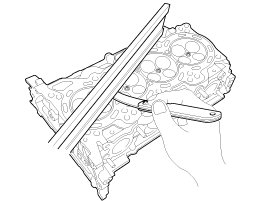
Using a precision straight edge and feeler gauge, measure the
contacting surface of the cylinder block and the manifolds for warpage.
Flatness of cylinder head gasket
surface:
Less than 0.05 mm (0.0020 in.) for total area
Less than 0.02 mm (0.0008 in.) for a section of 100 mm
(3.9370 in.) X 100 mm (3.9370 in.)
|
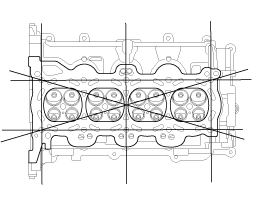
Flatness of manifold mounting
surface:
Less than 0.10 mm (0.0039 in.)
|
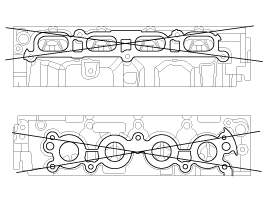
|
|
2. |
Inspect for cracks.
Check the combustion chamber, intake ports, exhaust ports and
cylinder block surface for cracks. If cracked, replace the cylinder
head.
|
Valve And Valve Spring
|
1. |
Inspect valve stems and valve guides.
|
(1) |
Using a caliper gauge, measure the inside diameter of
the valve guide.
Valve guide inner diameter
Intake: 5.500 ~ 5.512 mm (0.21654 ~ 0.21701 in.)
Exhaust: 5.500 ~ 5.512 mm (0.21654 ~ 0.21701 in.)
|
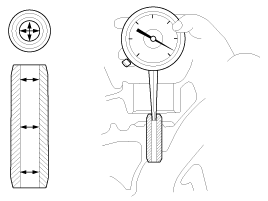
|
|
(2) |
Using a micrometer, measure the diameter of the valve
stem.
Valve stem outer diameter
Intake: 5.465 ~ 5.480 mm (0.21516 ~ 0.21575 in.)
Exhaust: 5.458 ~ 5.470 mm (0.21488 ~ 0.21535 in.)
|
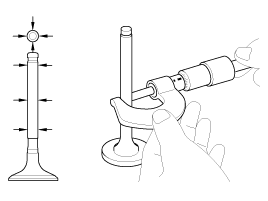
|
|
(3) |
Subtract the valve stem diameter measurement from the
valve guide inside diameter measurement.
If the clearance is greater than specification, replace
the valve or the cylinder head.
Valve stem-to-guide
clearance
[Standard]
Intake : 0.020 ~ 0.047 mm (0.00079 ~ 0.00185 in.)
Exhaust : 0.030 ~ 0.054 mm (0.00118 ~ 0.00213
in.)
|
|
|
|
2. |
Inspect the valves.
|
(1) |
Check the valve is ground to the correct valve face angle.
|
|
(2) |
Check that the surface of the valve for wear.
If the valve face is worn, replace the valve.
|
|
(3) |
Check the valve head margin thickness.
If the margin thickness is less than specification, replace
the valve.
Margin
[Standard]
Intake: 1.30 mm (0.0512 in.)
Exhaust: 1.26 mm (0.0496 in.)
|
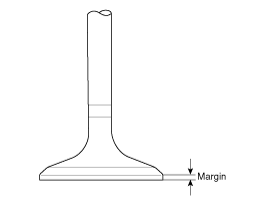
|
|
(4) |
Check the valve length.
Valve length
[Standard]
Intake: 102.22 mm (4.0244 in.)
Exhaust: 104.04 mm (4.0961 in.)
[Limit]
Intake: 101.97 mm (4.0146 in.)
Exhaust: 103.79 mm (4.0862 in.)
|
|
|
(5) |
Check the surface of the valve stem tip for wear.
If the valve stem tip is worn, replace the valve.
|
|
|
3. |
Inspect the valve seats and the valve guides.
|
(1) |
Check the valve seat for evidence of overheating and improper
contact with the valve face.
If the valve seat is worn, replace the cylinder head.
|
|
(2) |
Check the valve guide for wear.If the valve guide is worn,
replace the cylinder head.
|
|
|
4. |
Inspect the valve springs.
|
(1) |
Using a steel square, measure the out-of-square of valve
spring.
|
|
(2) |
Using a vernier calipers, measure the free length of valve
spring.
If the free length is not as specified, replace the valve
spring.
Valve spring
[Standard]
Free height: 45.93 mm (1.8083 in.)
Out-of-square : Less than 1.5┬░
|
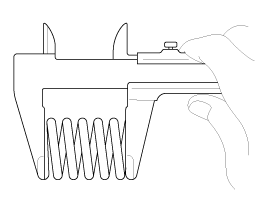
|
|
Hydraulic Lash Adjuster (HLA)
With the HLA filled with engine oil, hold A and press B by hand.
If B moves, replace the HLA.
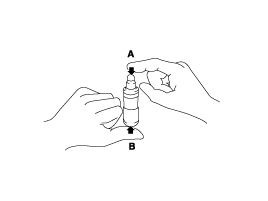
Problem
|
Possible cause
|
Action
|
1. Temporary noise when starting a cold engine
|
Normal
|
This noise will disappear after the oil in the engine reaches
the normal pressure.
|
2. Continuous noise when the engine is started after parking
more than 48 hours
|
Oil leakage of the high pressure chamber on the HLA, allowing
air to get in
|
Noise will disappear within 15 minutes when engine runs at 2000-3000
rpm.
If it doesnŌĆÖt disappear, refer to step 7 below.
|
3. Continuous noise when the engine is first started after rebuilding
cylinder head
|
Insufficient oil in cylinder head oil gallery
|
4. Continuous noise when the engine is started after excessively
cranking the engine by the starter motor or band
|
| ŌĆó
|
Oil leakage of the high-pressure chamber in the HLA, allowing
air to get in
|
| ŌĆó
|
Insufficient oil in the HLA
|
|
5. Continuous noise when the engine is running after changing
the HLA
|
|
Do not run engine at a speed higher than 3000 rpm, as
this may damage the HLA.
|
|
6. Continuous noise during idle after high engine speed
|
Engine oil level too high or too low
|
| ŌĆó
|
Drain or add oil as necessary.
|
|
Excessive amount of air in the oil at high engine speed
|
Check oil supply system.
|
Deteriorated oil
|
Check oil quality.
If deteriorated, replace with specified type.
|
7. Noise continues for more than 15 minutes
|
Low oil pressure
|
Check oil pressure and oil supply system of each part of engine.
|
Faulty HLA
|
Remove the cylinder head cover and press HLA down by hand.
If it moves, replace the HLA.
|
Identify, valves and valve springs as they are removed so that
each item can be reinstalled in its original position.
...
ŌĆó
Thoroughly clean all parts to be assembled.
ŌĆó
...
 Kia Forte: Cylinder Head Inspection
Kia Forte: Cylinder Head Inspection
 Cylinder Head Disassembly
Cylinder Head Disassembly Cylinder Head Reassembly
Cylinder Head Reassembly







